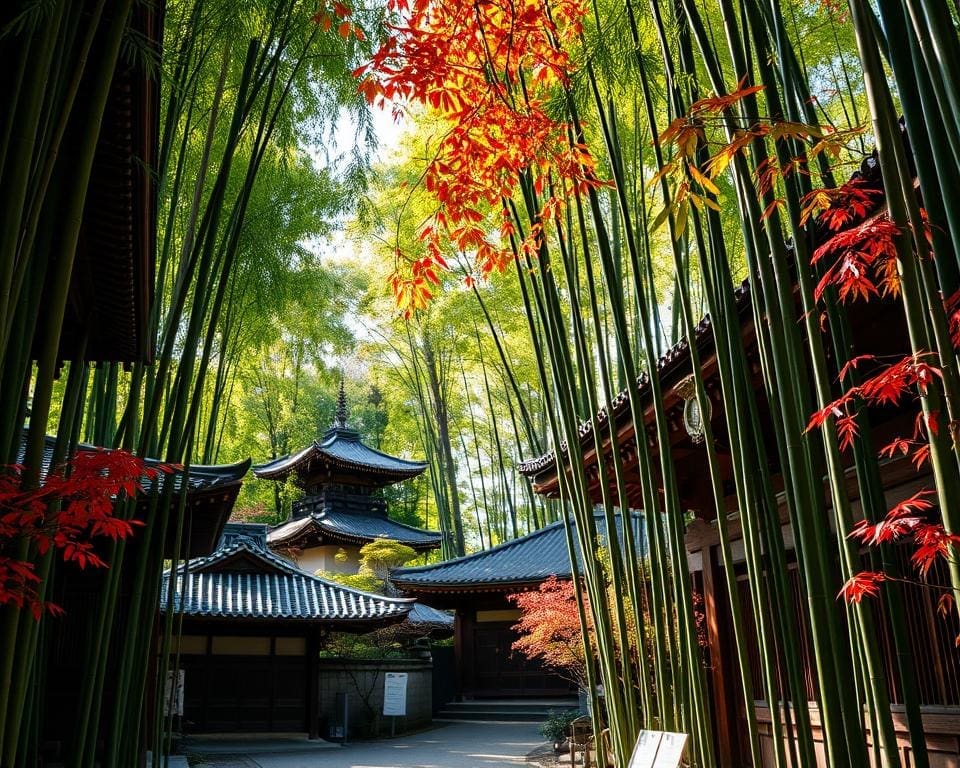Kyoto, a city steeped in history and tradition, serves as Japan’s former capital and a fascinating destination for anyone seeking a deep dive into the rich cultural tapestry of the nation. Renowned for its stunning natural beauty, Kyoto is a shining example of the harmonious blend between traditional temples and bamboo forests. This Kyoto travel guide will take you through enchanting landscapes and sacred sites, providing insight into the serene atmosphere that reigns supreme in this remarkable city. Journey with us as we explore the best of Kyoto tourism, uncovering the timeless allure created by its intricate temples and magical bamboo groves.
Discover the Best Temples in Kyoto
Kyoto’s landscape is adorned with numerous temples, each featuring a distinct architectural style and a rich tapestry of history. These sacred sites not only offer spirituality but also provide visitors with a glimpse into Japan’s cultural heritage. The remarkable aspects of Kyoto attractions are found in their ability to transport individuals back in time, echoing stories of centuries past.
Historical Significance of Kyoto’s Temples
The temples of Kyoto stand as testaments to the city’s enduring legacy. Their architectural grandeur mirrors the historical significance of temples, showcasing Japan’s artistic evolution over the centuries. Each temple encapsulates unique periods of Japanese history, reflecting the philosophical thoughts and artistic trends of its time. Visitors have the opportunity to connect with the spiritual essence and cultural narratives embedded within these impressive structures.
Top Must-Visit Temples
Among the best temples in Kyoto, several truly stand out:
- Kinkaku-ji (Golden Pavilion) – Renowned for its exquisite beauty, this Zen temple is coated in gold leaf, creating a breathtaking reflection on the surrounding pond.
- Ryoan-ji – Famous for its iconic zen rock garden, it invites contemplation and meditation in a tranquil environment.
- Fushimi Inari Taisha – This shrine is celebrated for its thousands of vermilion torii gates winding up the sacred Mount Inari.
Temple Festivals and Cultural Events
The cultural vibrancy of Kyoto’s temples is further enhanced by its seasonal festivals. These temple festivals offer a vibrant glimpse into local traditions and community spirit, attracting both locals and tourists alike. Engaging with these events deepens one’s appreciation for the historical significance of the temples and connects visitors to the local culture in a profound manner.

Kyoto: Traditional Temples and Bamboo Forests
For many visitors, a journey into Kyoto reveals a profound harmony between nature and spirituality. Amongst the breathtaking landscapes, the bamboo groves in Kyoto offer a tranquil retreat, allowing explorers to breathe in the beauty of their surroundings. This connection to nature is deeply woven into the fabric of the traditional temples and bamboo forests, enriching the experience for tourists.
Exploring the Serenity of Bamboo Groves in Kyoto
The bamboo groves in Kyoto represent one of the city’s most enchanting features. Walking through these towering stalks creates an atmosphere of peace and reflection. With sunlight filtering through the leaves, visitors often find themselves enveloped in a soothing silence that contrasts with the bustling streets of the city. The Arashiyama Bamboo Grove stands as a highlight in Kyoto tourism, drawing those seeking solace and inspiration. Each visit uncovers a different mood, influenced by the time of day and the seasons.
How Temples and Bamboo Forests Intertwine
The relationship between traditional temples and bamboo forests in Kyoto is noteworthy. Many temples are surrounded by lush greenery, including bamboo, which enhances their spiritual environments. This natural setting complements the serene architecture, as visitors often experience a seamless blend of spirituality and nature. Notable locations, such as Tenryu-ji Temple, illustrate how these elements coexist, providing a serene backdrop for contemplation. Such interactions deepen the cultural significance of Kyoto, making it a unique destination for those exploring the allure of Japan.
Must-Visit Attractions in Kyoto for Sightseeing
Kyoto is a treasure trove of cultural and historical wonders, making it an essential destination for those interested in immersive experiences. Among the must-visit places in Kyoto, the iconic Kinkaku-ji, also known as the Golden Pavilion, stands out with its stunning reflection shimmering on the tranquil waters. This zen temple encapsulates the harmony of nature and architecture, drawing countless visitors eager to witness its beauty. Coupled with the serene Ryoan-ji rock garden, these sites epitomise the tranquil essence of Kyoto tourism.
In addition to its renowned temples, Kyoto offers lush landscapes that enchant nature enthusiasts. The Arashiyama Bamboo Grove is not just a delightful escape into towering greenery but also a place of tranquillity, ideal for relaxing strolls. The sound of bamboo swaying in the wind creates a unique atmosphere that captures the hearts of all who explore it. Such experiences form the backbone of Kyoto sightseeing, where every corner reveals something new to appreciate.
Furthermore, festivals and cultural events provide an engaging way to experience the city’s rich traditions. Visitors can partake in celebrations like the Gion Matsuri, which showcases vibrant parades and traditional music. These events highlight the significance of Kyoto’s cultural fabric and demonstrate why it remains one of the must-visit places in Kyoto for those seeking authentic experiences. In summarising Kyoto tourism, perhaps the most compelling draw is the city’s ability to enchant all who arrive, inviting them to journey through its storied streets and breathtaking landscapes.









